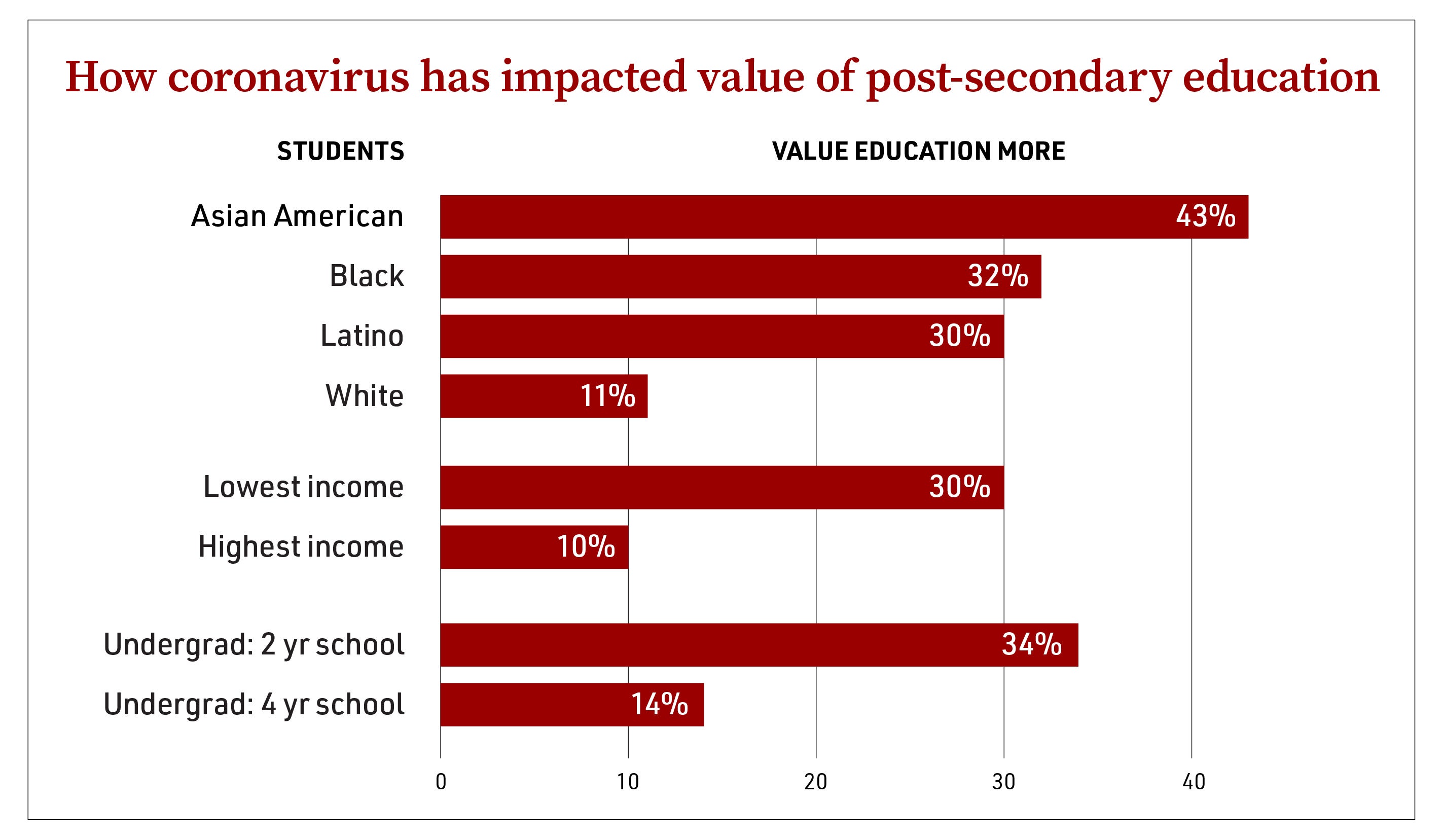
Pandemic may delay college graduation for students of color
The COVID-19 pandemic is having a striking, paradoxical impact on low-income and minority college students. At least 30% of Black, Latino and Asian American students say the pandemic has increased their perceived value of a college education, compared to only 11% of white students. Yet, students of color and low-income students are much more likely to say they’re planning to take fewer classes in the fall, likely delaying their graduation.
The findings are from the Understanding Coronavirus in America Study conducted by the Center for Economic and Social Research (CESR) at USC Dornsife College of Letters, Arts and Sciences.
The study’s nationally representative survey includes 998 households with at least one individual currently enrolled in an undergraduate or graduate program at a community college or four-year institution as of the 2019–20 school year.
Conducted across three waves from April 29 – July 21, 2020, it reveals 22% of college students overall value a higher education more since the beginning of the pandemic, compared to just 11% who value it less. But the differences by race and income are significant.
How coronavirus has impacted value of post-secondary education

Several factors could explain how the pandemic has impacted the perceived value of higher education, according to Anna Saavedra, behavioral scientist at CESR, and Morgan Polikoff, associate professor of education at USC Rossier School of Education. Saavedra and Polikoff co-direct the education portion of the Understanding Coronavirus in America Study.
“We also learned from the survey that Americans who are less educated, people of color, or from lower income households, are far more likely to express fear about the health effects of the virus,” said Saavedra. “Since 54% of college graduates have been able to limit their exposure to COVID-19 by teleworking during the pandemic, compared to 23% of those with a high school diploma but no college coursework, it’s possible the coronavirus has heightened the value of a college degree for both health and economic reasons.”
Just 3% of white students plan to take fewer classes in the fall because of the pandemic, whereas nearly 30% of Asian American, almost 25% of Latino, and 7% of Black students said they expect to take a lighter course load when the new school year starts, as do 18% of the lowest-income students. These differences may be explained by large gaps in the impact of COVID-19 on students’ family care responsibilities: Latino, Asian American, and low-income students are far more likely to report increases in these responsibilities resulting from COVID-19.
The pandemic’s impact on the post-secondary education plans of students of color is troubling, said Dominique Baker, assistant professor of education policy at Southern Methodist University’s Annette Caldwell Simmons School of Education and Human Development.
“The survey results suggest that students of color view higher education as a way to create more economic security and protection from the ravages of the pandemic,” said Baker.
She said it’s troubling that the students who feel they need a credential the most are also the ones who are reducing their course loads. “Reducing one’s course load makes it more likely that you will not complete, that it will take you longer to complete if you do, that you have to take out more student loan debt because of the extended time to degree, etc. Students of color are balancing additional responsibilities beyond school that will not allow them to focus on their coursework the way their peers may be able to.”
Of students who were already enrolled in some form of postsecondary education prior to the pandemic, only 2% are not planning to enroll in the fall because of COVID-19 and just 3% cited coronavirus as the reason they’re changing institutions.
Pandemic’s impact on K-12 grade students
The study also included an analysis of data regarding the impact of the pandemic on K-12 grade students. Key findings include:
- Overall, three quarters of parents support having fully in-person and remote-only options for the fall semester.
- More than half of lower-income families think schools should stay closed for the entire 2020–21 school year compared to 27% of families in the highest income bracket.
- Half of families report being concerned or very concerned about the quality of the education their schools will deliver under full or partial distance learning, with greater concern among families of color and lower-income households.
Differences in parents’ level of fear of coronavirus, expressed as their perceived likelihood of being hospitalized or dying from COVID-19, may explain why a majority of lower-income families prefer schools to stay closed.
Study results show parents of K-12 children with annual household incomes below $50,000 believe, if infected, they have a 22% chance of death, compared to a 6% chance of death reported by parents in households with incomes above $150,000. These differential perceptions align with data indicating that lower income and racial minority households and individuals are disproportionately at-risk of death if infected by COVID-19.
About the Study
The Understanding Coronavirus in America Study regularly surveys a panel of more than 7,000 people throughout the country to learn how COVID-19 impacts their attitudes, lives and behaviors. Post-secondary and K12 education survey questions, methodology, topline data, and crosstabs are available here: https://uasdata.usc.edu/index.php.
The study, supported in part by the Bill & Melinda Gates Foundation, the National Science Foundation Discovery Research preK-12 program, and USC, is updated daily and available to researchers and the public at: covid19pulse.usc.edu.